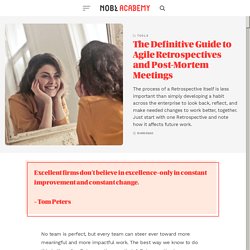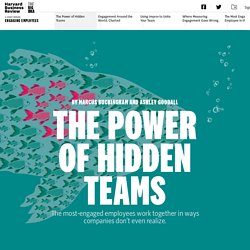

Serious eLearning Manifesto – By putting forth this Manifesto, Michael Allen, Julie Dirksen, Clark Quinn, and Will Thalheimer invite all learning professionals to pledge to do the things that are necessary to create an engaging and effective experience fo. (19) Regressieve, stagnerende en verwaarloosde teams. The abrupt shift to remote agile teams. As organizations adapt to the ongoing COVID-19 crisis, their agile teams can be a real source of competitive advantage.

Such teams are typically well suited to periods of disruption, given their ability to adapt to fast-changing business priorities, disruptive technology, and digitization. But the abrupt shift to remote working in response to the coronavirus has challenged the typical approach to managing agile teams. Traditionally, such teams thrive when team members are co-located, with close-knit groups all working in the same place. Co-location allows frequent in-person contact, quickly builds trust, simplifies problem solving, encourages instant communication, and enables fast-paced decision making. To weather a crisis, build a network of teams. This article is part of a series Leadership in a crisis: Responding to the coronavirus outbreak and future challenges.

It draws together McKinsey’s collective thinking and expertise on five behaviors to help leaders navigate the pandemic and recovery. Nowhere: Insight. Ingredients That Make the Best Teams Successful - The Helm - Medium. Great teams have great leaders and great individuals.

They all work together to raise the overall performance of the team. What makes the best teams successful? The Definitive Guide to Agile Retrospectives and Post-Mortem Meetings - NOBL Academy. Excellent firms don’t believe in excellence–only in constant improvement and constant change. – Tom Peters No team is perfect, but every team can steer ever toward more meaningful and more impactful work.

The best way we know to do this is through a Retrospective meeting. Practices for Productive Teams - The Startup - Medium. Teamwork is dead.

Long live teamwork. It’s been over 15 years since the best-selling The Five Dysfunctions of a Team (Lencioni, 2002) popularized some of the common pitfalls associated with teamwork in business settings, and you might think that the enormous volumes written on teamwork since then has saturated the market. Google Research Reveals 7 Secrets of Successful Remote Teams. Team Coaching International. A team is a living system—more than a collection of individual parts.

A team as a system has rules for belonging and behavior. Those rules are not written down in the employee handbook. New team members learn the rules by observing and by touching the hot wire or being rewarded with a pat on the back. Leadership and innovation. Like short skirts, innovation has traditionally swung into and out of fashion: popular in good times and tossed back into the closet in downturns. But as globalization tears down the geographic boundaries and market barriers that once kept businesses from achieving their potential, a company's ability to innovate—to tap the fresh value-creating ideas of its employees and those of its partners, customers, suppliers, and other parties beyond its own boundaries—is anything but faddish. In fact, innovation has become a core driver of growth, performance, and valuation. Our research bears out this point.
More than 70 percent of the senior executives in a survey we recently conducted say that innovation will be at least one of the top three drivers of growth for their companies in the next three to five years. Other executives see innovation as the most important way for companies to accelerate the pace of change in today's global business environment. The Power of Hidden Teams. Latest Digital Article What her work and life might look like.

Two nurses. Same job; different hospitals. One provides great care for patients, the other doesn’t. Three Steps to Help Innovation Teams Succeed at an Established Company. Fielding high-performing innovation teams. Innovation is a team sport.

For projects to succeed, they must be staffed with the right combination of talent. Here is how to ensure your initiatives have the players they need to win. The CEO of a globally recognized bank is frustrated with the lack of innovation performance delivered by her company. She sets up an incubator charged with developing a portfolio of new high-growth businesses. Inside this incubator, she places teams of high performers from the core businesses of the bank in part-time roles.
CEOs of other companies face similar challenges around innovation. A practical guide for putting together agile teams. What personality traits and values help agile teams bloom?

Discover ways to identify these when recruiting and coaching your people. To survive and thrive, many organizations are making the effort to become more agile. Whereas traditional organizations seem mechanical, hierarchical, and linear, agile organizations feel more organic: they balance stability with dynamism and can adapt for an ever-changing, unpredictable future. Unleashing the power of agile teams. Small, independent teams are the lifeblood of the agile organization.

Top executives can unleash them by driving ambition, removing red tape, and helping managers adjust to the new norms. What does it take to set loose the independent teams that make agile organizations hum? How Agile Teams Can Help Turnarounds Succeed. Why a culture of violent politeness is killing your teams. “If there is more truth in the hallways than in meetings, you have a problem.” — Ed Catmull, Pixar Teams live or die by the quality of their communication, and I’ve become particularly interested in the notion that some of our biggest problems arise from phenomena like wilful blindness and conflict avoidance. So when I came across this phrase “violent politeness” in “The Leading Brain” by Friederike Fabritius and Hans W.
Hagemann, I had a moment of pure delight. The authors describe violent politeness as “the silent killer of effective communication.” Publikationen & Tools. 3 Types Of Dysfunctional Teams And How To Fix Them. You might be reading this while taking a break from any of the team meetings that are integral to your job. Maybe it’s a team of company all-stars–a cross-functional team of high performers–that is key to tackling important challenges at your company. Regardless of the type, how is your team working out? That question surfaces regularly for most of us–and it usually comes from the boss or other higher-ups in a ritual pulse check. There’s good reason for making sure things are clicking. According to a EY (formerly Ernst & Young) survey of global business executives, most business leaders view high-performance teams as essential to success. Five Strategies for Leading a High-Impact Team. Nobody sets out to lead an ineffective team.
In fact, leaders agonize over fostering teams that work well together and deliver smart solutions time and time again—the kind of teams that, in Leigh Thompson’s words, “go through the various storms, the successes, the failures, and keep coming out alive.” The only problem? Many of the strategies leaders have adopted to improve teamwork, while well-intentioned, are not all that effective. Groups as complex systems – Daniel Christian Wahl – Medium. Any system with three or more interacting variables is a complex dynamic system. In each human being a myriad of biological, psychological, and physical variables interact constantly. Therefore we can regard human beings as complex systems, and any group of two or more of these systems is thus also a complex system.
From this perspective, groups are complex, adaptive, dynamic systems of interacting individuals. The members are the basic components of the system, who are coupled to each other by relationships. Like all living systems, groups can be self-creating and self-organizing systems (autopoietic systems). Just like all living systems receive inputs from the environment, process this information and resources internally, and then output their products, groups gather information, review that information, and generate products. Boek Succesvol dankzij internet.
Use Culture Cards as a Team Building Exercise — NOBL Collective - The Future of Work. If Your Team Agrees on Everything, Working Together Is Pointless. Team Diagnostic. Neglect. Why Less Is More in Teams. Why is it that American football uses eleven players, Canadian football twelve, and Gaelic fifteen?
Research Roundup: Team Performance, Demystifying Market Composition and the Reality vs. Hype of Sponsored Search. How do interpersonal relationships affect the performance of individual team members? Team Design Bootcamp — NOBL Collective - The Future of Work. Our concepts - Relation Technologies. Nieuwsbrief 56 : Lente 2016 – De paradoxen van zelfsturende teams. Network leadership. Network leadership The industrial approach to leadership places a heavy emphasis on the formulation of intentions and plans and then communicating them as action points to be implemented by others. Building Trust in Your Team: The Trust Matrix. Modeled After Ants, Teams of Tiny Robots Can Move 2-Ton Car. Archimedes pointed out that with a lever he could move the world. So Rozovsky started looking for other groups she could join.
Untitled. Earlier this week, Google announced a list of new features for Google Forms. No Dickheads! A Guide To Building Happy, Healthy, And Creative Teams. Wellevue. 3 Must-Read Decks on Content Marketing. If Teams Are So Great, Why Do We Have So Much Trouble With Them? — The Future of Work and Business.
The Customer Discovery Handbook.